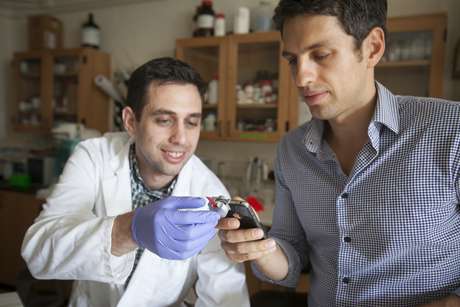Picture of health: A selfie that may save your life

(Phys.org) —With a new smartphone device, you can now take an accurate iPhone camera selfie that could save your life – it reads your cholesterol level in about a minute.
Forget those clumsy, complicated, home cholesterol-testing devices. Cornell engineers have created the Smartphone Cholesterol Application for Rapid Diagnostics, or "smartCARD," which employs your smartphone's camera to read your cholesterol level.
"Smartphones have the potential to address health issues by eliminating the need for specialized equipment," said David Erickson, Cornell associate professor of mechanical engineering and senior author on a new peer-reviewed study. Thanks to advanced, sophisticated camera technology, Erickson and his colleagues have created a smartphone accessory that optically detects biomarkers in a drop of blood, sweat or saliva. The new application then discerns the results using color analysis.
When a user puts a drop of blood on the cholesterol test strip, it processes the blood through separation steps and chemical reactions. The strip is then ready for colorimetric analysis by the smartphone application.
The smartCARD accessory – which looks somewhat like a smartphone credit card reader – clamps over the phone's camera. Its built-in flash provides uniform, diffused light to illuminate the test strip that fits into the smartCARD reader. The application in the phone calibrates the hue saturation to the image's color values on the cholesterol test strip, and the results appear on your phone.
Currently, the test measures total cholesterol. The Erickson lab is working to break out those numbers in LDL ("bad" cholesterol), HDL ("good" cholesterol) and triglyceride measurements. The lab is also working on detecting vitamin D levels, and has previously demonstrated smartphone tests for periodontitis and sweat electrolyte levels.
The article, "Cholesterol Testing on a Smartphone," appeared online Nov. 28 in the journal Lab on a Chip, also co-authored by Vlad Oncescu and Matthew Mancuso, Cornell graduate students in the field of engineering. This study was funded by the National Science Foundation, the Engineering Research Council of Canada and Cornell's David R. Atkinson Center for a Sustainable Future.
In a related study, the Atkinson Center provided academic venture funding on an application that analyzes micronutrients on a smartphone – so that phones can track micronutrient deficiencies for world populations. Working on this project are Erickson; Saurabh Mehta, Cornell assistant professor of nutritional sciences; Julia Finkelstein, researcher in nutritional sciences; and Joe Francis, associate professor in development sociology.
"By 2016, there will be an estimated 260 smartphones in use in the United States. Smartphones are ubiquitous," said Erickson, adding that although smartCARD is ready to be brought to market immediately, he is optimistic that it will have even more its advanced capabilities in less than a year. "Mobil health is increasing at an incredible rate," he concluded. "It's the next big thing."
More information:
"Cholesterol testing on a smartphone." Vlad Oncescu, Matthew Mancuso, David Erickson Lab Chip, 2013,,
DOI: 10.1039/C3LC51194D Received 21 Oct 2013, Accepted 28 Nov 2013. First published online 28 Nov 2013
Journal information: Lab on a Chip
Provided by Cornell University



















